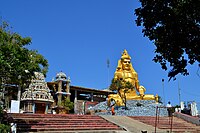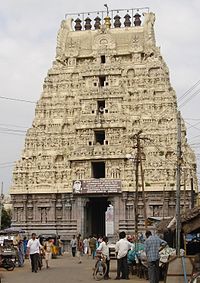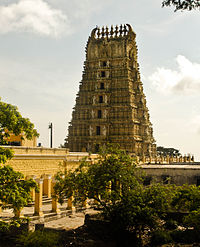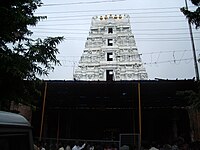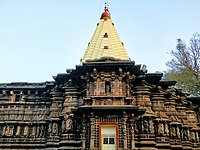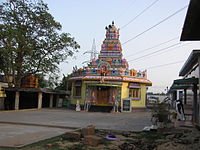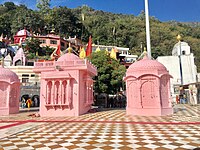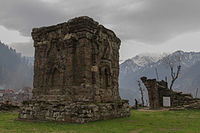Shakta pithas
This article has multiple issues. Please help improve it or discuss these issues on the talk page. (Learn how and when to remove these messages)
|
| Part of a series on |
| Shaktism |
|---|
 |
|
|
| Part of a series on |
| Hinduism |
|---|
 |
The Shakti Peeth (Template:Lang-sa, Śakti Pīṭha, seat of Shakti[1]) are significant shrines and pilgrimage destinations in Shaktism, the goddess-focused Hindu tradition. There are 51 or 108 Shakti peethas by various accounts,[2][3] of which between 4 and 18 are named as Maha (major) in medieval Hindu texts.[2]
Most of these historic places of goddess worship are in India, but there are seven in Bangladesh, three in Pakistan, two in Nepal, and one each in Tibet and Sri Lanka.[3]
Various legends explain how the Shakti Peetha came into existence. The most popular is based on the story of the death of the goddess Sati. Out of grief and sorrow, Shiva carried Sati's body, reminiscing about their moments as a couple, and roamed around the universe with it. Vishnu had cut her body into 52 body parts, using his Sudarshana Chakra, which fell on Earth to become sacred sites where all the people can pay homage to the Goddess. To complete this massively long task, Lord Shiva took the form of Bhairava.
Legend
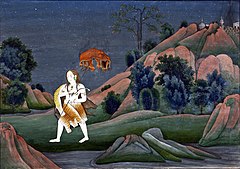
Lord Brahma performed a yajna (Vedic ritual of fire sacrifice) to please Shakti and Shiva. Goddess Shakti emerged, separating from Shiva and helped Brahma in the creation of the universe. Brahma decided to give Shakti back to Shiva. Therefore, his son Daksha performed several yagnas to obtain Shakti as his daughter in the form of Sati. It was then decided that Sati was brought into this world with the motive of getting married to Shiva.
However, due to Lord Shiva's curse to Brahma that his fifth head was cut off due to his lie in front of Shiva, Daksha started hating Lord Shiva and decided not to let Lord Shiva and Sati get married.
However, Sati got attracted to Shiva and finally one day Shiva and Sati got married. This marriage only increased Daksha's hatred towards Lord Shiva.
Daksha performed a yagna with a desire to take revenge on Lord Shiva. Daksha invited all the deities to the yajna except Lord Shiva and Sati. The fact that she was not invited did not deter Sati from attending the yagna. She expressed her desire to attend the yagna to Shiva, who tried his best to dissuade her from going. Shiva eventually relented and Sati went to the yagna. Sati, being an uninvited guest, was not given any respect at the yagna. Furthermore, Daksha insulted Shiva. Sati was unable to bear her father's insults toward her husband, so she immolated herself.
Enraged at the insult and the injury, Shiva in his Virabhadra avatar destroyed Daksha's yagna, cut off Daksha's head, and later replaced it with that of a male goat as he restored him to life.Virabhadra didn't stop fighting; he kept raging with anger. Gods prayed to lord Vishnu. He came there and started fighting him. Still immersed in grief, Shiva picked up the remains of Sati's body, and performed the Tandava, the celestial dance of destruction, across all creation. The other Gods requested Vishnu to intervene to stop this destruction, towards which Vishnu used the Sudarshana Chakra, which cut through Sati's corpse. The various parts of the body fell at several spots all through the Indian subcontinent and formed sites which are known as Shakti Peethas today.[4]
At all the Shakti Peethas, the Goddess Shakti is accompanied by her consort, Lord Bhairava (a manifestation of Lord Shiva). Shakti is an aspect of the Supreme Being Adi parashakti, the mother of the trimurti, the holy trinity in Hindu religion & scriptures.
Sati's self-immolation
The history of Daksha yajna and Sati's self-immolation had immense significance in shaping the ancient Sanskrit literature and even influenced the culture of India. It led to the development of the concept of Shakti Peethas and thereby strengthened Shaktism. Enormous numbers of stories in the Puranas and other Hindu religious books took the Daksha yagna as the reason for their origin. It is an important incident in Shaivism, resulting in the emergence of Parvati in the place of Sati Devi and making Shiva a grihastashrami (house holder), leading to the origin of Ganesha and Kartikeya.[5]
Shakti Peethas are shrines or divine places of the Mother Goddess. These are places that are believed to have been blessed with the presence of Shakti due to the falling of body parts of the corpse of Sati Devi, when Lord Shiva carried it and wandered throughout Aryavartha in sorrow. There are 51 Shakti Peeth linking to the 51 alphabets in Sanskrit.[6] Each temple has shrines for Shakti and Kalabhairava, and most Shakti and Kalabhairava in different Shakti Peeth have different names.
Four Adi Shakti Pithas
Some of the great religious texts like the Shiva Purana, the Devi Bhagavata, the Kalika Purana and the AstaShakti recognize four major Shakti Peethas (centers), like Bimala (Pada Khanda) (inside the Jagannath Temple of Puri, Odisha), Tara Tarini (Sthana Khanda, Purnagiri, Breasts) (Near Berhampur, Odisha), Kamakhya Temple (Yoni Khanda) (Near Guwahati, Assam) and Dakshina Kalika (Mukha Khanda) (Kolkata, West Bengal) originated from the parts of the corpse of Mata Sati in the Satya Yuga.
The Ashtashakti and Kalika Purana says (in Sanskrit):
- "Bimala Pada khandancha,
- Stana khandancha Tarini (Tara Tarini),
- Kamakhya Yoni khandancha,
- Mukha khandancha Kalika (Dakshina Kalika)
- Anga pratyanga sanghena
- Vishnu Chakra Kshyta nacha"
Further explaining the importance of these four Pithas, the "Brihat Samhita" also gives the location of these Pithas as (in Sanskrit)
- "Rushikulya* Tatae Devi,
- Tarakashya Mahagiri,
- Tashya Srunga Stitha Tara
- Vasishta Rajitapara" (Rushikulya is a holy river flowing on the foothill of the Tara Tarini Hill Shrine).
In the listings below:
- "Shakthi" refers to the Goddess worshiped at each location, all being manifestations of Dakshayani (Sati), Parvati or Durga;
- "Body Part or Ornament" refers to the body part or piece of jewelry that fell to earth, at the location on which the respective temple is built.
| Temple | City/Town | State in India/Country | Body Part | Image |
|---|---|---|---|---|
| Vimala Temple | Puri | Odisha | navel | 
|
| Taratarini Temple | Berhampur | Odisha | breast | 
|
| Kamakhya Temple | Guwahati | Assam | yoni (genitals) | 
|
| Kalighat Kali Temple | Kolkata | West Bengal | right toe | 
|
Apart from these 4 there are 51 other famous Peethas recognized by religious texts. According to the Pithanirnaya Tantra the 51 peethas are scattered all over present day countries of India, Sri Lanka, Bangladesh, Nepal, Tibet, Bhutan and Pakistan. The Shivacharita besides listing 51 maha-peethas, speaks about 26 more upa-peethas. The Bengali almanac, Vishuddha Siddhanta Panjika too describes the 51 peethas including the present modified addresses. A few of the several accepted listings are given below.[7] One of the few in South India, Srisailam in Andhra Pradesh became the site for a 2nd-century temple.[8]
The List of Shakti Pithas
In the listings[9] below:
- "Shakti" refers to the Goddess worshipped at each location, all being manifestations of Dakshayani, Sati; later known as Parvati or Durga;
- "Bhairava" refers to the corresponding consort, each a manifestation of Shiva;
- "Body Part or Ornament" refers to the body part or piece of jewellery that fell to earth, at the location on which the respective temple is built.
| Sr. No. | Place | State in India/Country | Body Part or Ornament | Shakti | Bhairava | Image |
|---|---|---|---|---|---|---|
| 1 | A.Amarnath Temple, from Srinagar through Pahalgam 94 km by Bus, Chandanwari 16 km by walk B. Shri Parvat in Ladakh |
Jammu and Kashmir | A. Throat B. Anklet |
Mahamaya | Trisandhyeshwar | 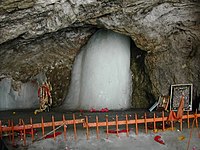
|
| 2 | At a village also named as Attahas or Ashtahas around 2 km east of Labhpur village road in the district of Birbhum | West Bengal | Lips | Phullara | Vishvesh | |
| 3 | Bahula, on the banks of Ajay river at Ketugram, 8 km from Katwa, Burdwan | West Bengal | Left arm | Goddess Bahula | Bhiruk | |
| 4 | Bakreshwar, on the banks of Paaphara river, 24 km distance from Siuri Town [a district headquarter], district Birbhum, 7 km from Dubrajpur Rly. Station | West Bengal | Portion between the eyebrows | Mahishmardini | Vakranath | |
| 5 | Bhairavparvat, at Bhairav hills on the banks of Shipra river in the city of Ujjaini. These Shaktpeeth known as Harsiddi temple. | Madhya Pradesh | Elbow | Avanti | Lambkarna | |
| 6 | Bhabanipur, located in the Upazila of Sherpur, Bogra, Rajshahi Division. Also located at Karatoyatat, it is about 28 km distance from the town of Sherpur. | Bangladesh | Left anklet (ornament) | Aparna | Vaman | |
| 7 | Chhinnamastika Shaktipeeth at Chintpurni, in Una District of Himachal Pradesh | Himachal Pradesh | Feet | Chhinnamastika | Rudra Mahadev | |
| 8 | Muktinath Temple[10] | Nepal | Temple | Gandaki Chandi | Chakrapani | 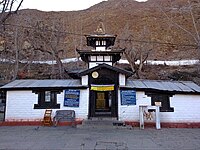
|
| 9 | Goddess Bhadrakali on banks of Godavari in Nashik city (Saptashrungi) | Maharashtra | Chin (2 parts) | Bhramari | Vikritaksh | |
| 10 | Hinglaj | Pakistan | Bramharandhra (Part of the head) | Kottari | Bhimlochan | |
| 11 | Jayanti at Nartiang village in the Jaintia Hills district. This Shakthi Peetha is locally known as the Nartiang Durga Temple. | Meghalaya | Left thigh | Jayanti | Kramadishwar | |
| 12 | Jeshoreshwari Kali Temple | Bangladesh | Palms of hands and soles of the feet | Jashoreshwari | Chanda | |
| 13 | Jwalaji, Kangra from Pathankot alight at Jwalamukhi Road Station from there 20 km | Himachal Pradesh | Tongue | Siddhida (Ambika) | Unmatta Bhairav | |
| 14 | Kalipeeth, (Kalighat, Kolkata) | West Bengal | Right Toes | Kalika | Nakuleshwar | |
| 15 | Kalmadhav on the banks of Son River in a cave over hills near to Amarkantak | Madhya Pradesh | Left buttock | Kali | Asitang | |
| 16 | Kamgiri, Kamakhya, in the Neelachal hills in Guwahati | Assam | Genitals | Kamakhya | Umanand | |
| 17 | Kankalitala, on the banks of Kopai River 10 km north-east of Bolpur station in Birbhum district, Devi locally known as Kankaleshwari | West Bengal | Pelvis | Devgarbha | Ruru | |
| 18 | Kanyashram of Balaambika - The Bhagavathy temple in Kanyakumari, the southernmost tip of mainland India, Tamil Nadu (also thought to be situated in Yunnan province, China) | Tamil Nadu | Back | Sarvani | Nimish | |
| 19 | Karnat, Brajeshwari Devi, Kangra | Himachal Pradesh | Ears | Jayadurga | Abhiru | |
| 20 | Kireet at Kireetkona village, 3 km from Lalbag Court Road station under district Murshidabad | West Bengal | Crown | Vimla | Sanwart | |
| 21 | Locally known as Anandamayee Temple. Ratnavali, on the banks of Ratnakar river at Khanakul I Krishnanagar, district Hooghly | West Bengal | Right Shoulder | Kumari | Ghanteshwar | |
| 22 | 'A.Locally known as Bhramari Devi in Jalpaiguri near a small village Boda on the bank of river Teesta or Tri-shrota (combination of three flows) mentioned in Puranas B.Ma Malai Chandi Temple at Amta, Howrah |
West Bengal | A. Left leg B. Part of Left Knee |
Bhraamari | Ambar | |
| 23 | Manas, under Tibet at the foot of Mount Kailash in Lake Manasarovar, a piece of Stone | China | Right hand | Dakshayani | Amar | |
| 24 | Manibandh, at Gayatri hills near Pushkar 11 km north-west of Ajmer. People know this temple as Chamunda Mata Temple. | Rajasthan | Wrists | Gayatri | Sarvanand | |
| 25 | Mithila, near Janakpur railway station on the border of India and Nepal | Nepal | Left shoulder | Uma | Mahodar | |
| 26 | Nainativu (Manipallavam), Northern Province, Sri Lanka. Located 36 km from the ancient capital of the Jaffna kingdom, Nallur. The murti of the Goddess is believed to have been consecrated and worshipped by Lord Indra. The protagonist, Lord Rama and antagonist, Ravana of the Sanskrit epic Ramayana have offered obeisances to the Goddess. Nāga and Garuda of the Sanskrit epic Mahabharata; resolved their longstanding feuds after worshipping this Goddess. | Sri Lanka | Silambu (Anklets) | Indrakshi (Nagapooshani / Bhuvaneswari) | Rakshaseshwar (Nayanair) | |
| 27 | Guhyeshwari Temple | Nepal | Both Knees | Mahashira | Kapali | 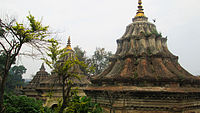
|
| 28 | Chandranath Temple | Bangladesh | Right arm | Bhawani | Chandrashekhar | |
| 29 | Panchsagar Near Lohaghat (in Champawat District of Uttarakhand) nearly 100 km from nearest railway station Tanakpur. पूर्णागिरी / DeviDhura Champawat Varahi Devi | Uttarakhand | Lower teeth/ Navel | Varahi | Maharudra | |
| 30 | Prabhas, 4 km from Veraval station near Somnath temple in Junagadh district. Local People call this temple as Kali Mandir, It is nearby Triveni Sangam. | Gujarat | Stomach | Chandrabhaga | Vakratund | |
| 31 | Prayaga Madhaveswari known as Alopi Mata near Sangam at Allahabad | Uttar Pradesh | Finger | Lalita | Bhava | |
| 32 | Present day Kurukshetra town or Thanesar ancient Sthaneshwar | Haryana | Ankle bone | Savitri/BhadraKali | Sthanu | |
| 33 | Sharda Peeth on top Trikoot Hill, at Maihar | Madhya Pradesh | necklace[11] | Shivani | Chanda | |
| 34 | Nandikeshwari Temple | West Bengal | Necklace | Nandini | Nandikeshwar | 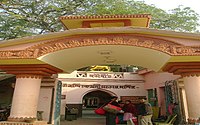
|
| 35 | Kotilingeswar Ghat temple on the banks of Godavari river near Rajamundry | Andhra Pradesh | Cheeks | Rakini or Vishweshwari | Vatsnabh or Dandpani | |
| 36 | Naina Devi Temple | Himachal Pradesh | Right Eye | Mahishmardini | Krodhish | |
| 37 | Shondesh, at the source point of Narmada River in Amarkantak | Madhya Pradesh | Right buttock | Narmada | Bhadrasen | |
| 38 | Srisailam in Shriparvat hills under Kurnool district | Andhra Pradesh | Right anklet (ornament) | Shrisundari | Sundaranand | |
| 39 | Sri Sailam, at Nallamalai hills, Andhra Pradesh | Andhra Pradesh, India | Neck | Mahalaxmi | Sambaranand | |
| 40 | Shuchi, in a Shiva temple at Suchindrum 11 km on Kanyakumari Trivandrum road | Tamil Nadu | Upper teeth | Narayani | Sanhar | |
| 41 | Sugandha, situated in Shikarpur, Gournadi, about 20 km from Barisal town, on the banks of Sonda river. | Bangladesh | Nose | Sugandha | Trayambak | |
| 42 | Udaipur, Tripura, at the top of the hills known as Tripura Sundari temple near Radhakishorepur village, a little distance away from Udaipur town | Tripura | Right leg | Tripura Sundari | Tripuresh | |
| 43 | Ujaani, at Mangalkot 16 km from Guskara station under Burdwan district | West Bengal | Right wrist | Mangal Chandika | Kapilambar | |
| 44 | Varanasi at Manikarnika Ghat on banks of the Ganges at Kashi | Uttar Pradesh | Earring | Vishalakshi & Manikarni | Kalbhairav | |
| 45 | Vibhash, at Tamluk under district Purba Medinipur | West Bengal | Left ankle | Kapalini (Bhimarupa) | Sarvanand | |
| 46 | virat nagar district alwar, near Bharatpur, India, or Virat Nagar Patiram area Of South Dinajpur District, | Rajasthan Or West Bengal | Fingers of Left Leg | Ambika | Amritaksha | |
| 47 | Vrindavan, near new bus stand on Bhuteshwar road within Bhuteshwar Mahadev Temple, Katyayanipeeth. Vrindavan www.katyayanipeeth.org.in | Uttar Pradesh | Ringlets of hair | Uma | Bhutesh | |
| 48 | Jalandhar, from Jalandhar Cantonment Station to Devi Talab. | Punjab | Left Breast | Tripurmalini | Bhishan | |
| 49 | Baidyanath Dham | Jharkhand | Heart | Jaya Durga | Baidyanath | |
| 50 | Kamakshi Amman Temple | Tamil Nadu | Odyanam(Navel) | Kamakshi | ||
| 51 | Jogadya (যোগাদ্যা), at Kshirgram (ক্ষীরগ্রাম) near Kaichar under Burdwan district | West Bengal | Great Toe | Jogadya (যোগাদ্যা) | Ksheer Kantak (ক্ষীর কন্টক) | |
| 52 | Pithapuram under Kakinada Port Town | Andhra Pradesh | Hip Part | Purohotika | ||
| 53 | Ambaji at Anart | Gujarat | Heart | Amba | Batuk Bhairav | |
| 54 | Jwaladevi Temple, Shaktinagar, Sonbhadra | Uttar Pradesh | Tongue | Jwala Devi | ||
| 55 | Chandika Sthan, near Munger town | Bihar | Left Eye | Chandika Devi | ||
| 56 | Danteshwari Temple, Dantewada | Chhattisgarh | Tooth or daant | Danteshwari devi | Kapalbhairav | |
| 57 | Juranpur, Nadia | West Bengal | ||||
| 58 | Tara Tarini, Berhampur, Ganjam | Odisha | Breast/Sthan | Maa Taratarini | Tumbeswar | |
| 59 | Nalhateswari, Nalhati | West Bengal | Stomach/Nauli | Kalika | Jogesh | |
| 60 | parameshwari shaktipith in patal | |||||
| 61 | dhakeshwari in Dhaka bangladesh here d gem of sati's crown had fallen | |||||
| 62 | bishwakama in north mansarovar | |||||
| 63 | billapatrika in bilwak | |||||
| 64 | brahmakala among living beings | |||||
| 65 | vaishnavi among matrikas | |||||
| 66 | indrani in amaravati | |||||
| 67 | parvati in kailash | |||||
| 68 | saraswati on Brahma's toungue | |||||
| 69 | lakshmi in vaikunth | |||||
| 70 | vindhyavasini in uttarpradesh back of sati had fallen | |||||
| 71 | pusti in devdaruvaan | |||||
| 72 | tillotama among apsaras | |||||
| 73 | arundhati among honest married ladies | |||||
| 76 | birasini in Madyapradesh | |||||
| 77 | karavipur, karachi, pakistan here third eye had fallen and shakti is mahisasurmardini | |||||
| 78 | shrunkhala Devi is in padua hoogly wb here stomach of sati had
Fallen | |||||
| 79 | rudrani at rudrakoti in kanchi tamilnadu | |||||
| 80 | sita at ramgiri chitrakut in mp | |||||
| 81 | urvashi in badrivan chamoli uttarakhand | |||||
| 82 | kushodhka in kushdweep in Nubia between Atbara and Nile Nubia in egypt | |||||
| 83 | aushadhi in uttarkaru in ladakh kashmir | |||||
| 84 | mansa shaktipith in Manimajra panchakola in Vilaspur in Chhattisgarh here head of sati had fallen | |||||
| 85 | shakambhari in saharanpur uttarpradesh here head of sati had fallen | |||||
| 86 | jayanti in falizur of Bangladesh left thigh of sati had fallen | |||||
| 87 | swaha in moheshwaripur | |||||
| 88 | sudhdhi in kapalmochan | |||||
| 89 | renuka in mahur, maharashtra | |||||
| 90 | jaya in barhaparvat | |||||
| 91 | lingadharini in nimisharanya in up | |||||
| 92 | bahuchara at mehsana in Gujarat with left hand of sati | |||||
| 93 | balasundari in trilokpur in himachal Pradesh | |||||
| 94 | baglamukhi in Datia madhyapradesh | |||||
| 95. | rukmini in dwarka | |||||
| 96 | dadhimati in nagaur of rajasthan | |||||
| 97 | biraja in Jajpur odisha | |||||
| 98 | pravavati in sunrays | |||||
| 99. | mangala gouri in gaya in bihar | |||||
| 100 | chandika in srihatta bangladesh | |||||
| 101. | vaindheshwari/vindhyavasini in vindhyachal in mirazpur of uttarpradesh | |||||
| 102 . | Chamundeshwari in Karnataka shaktipith | |||||
| 103. | sharda in Kashmir | |||||
| 104. | kamacharini in mandar hill bihar | |||||
| 105. | shanmardayini in kedar in rudraprayag uttarakhand | |||||
| 106. | goddess rambha in malayachal | |||||
| 107. | pavagadh in gujarat | |||||
| 108. | tuljabhawani in tuljapur maharashtra | |||||
| 109. | radhika in vrindavan | |||||
| 110. | Srawan Devi temple- Srawan devi temple is situated in city hardoi of uttar pradesh. It is one of ShaktiPeeth of devi SATI. It is says that the ear of the devi sati fallen in that place and a temple was built here thats why it is called Srawan devi temple. (Srawan Hindi name called ear in english) |
Historical notes
First relating to Brahmanda Purana, one of the major eighteen Puranas, it mentions 64 Shakthi Peetha of Goddess Parvati in the Bharat or Greater India including present day India, Bhutan, Bangladesh, Nepal, Sri Lanka, some parts of Southern Tibet and parts of southern Pakistan. Another text which gives a listing of these shrines, is the Shakthi Peetha Stotram, written by Adi Shankara, the 9th-century Hindu philosopher.[12]
According to the manuscript Mahapithapurana (c. 1690 – 1720 CE), there are 52 such places. Among them, 23 are located in the Bengal region, 14 of these are located in what is now West Bengal, India, 1 in Baster (Chhattisgarh), while 7 are in what is now Bangladesh.
Rishi Markandeya composed the 'Devi Saptashati' or the seven hundred hymns extolling the virtues of the Divine Goddess at the shaktipeetha in Nashik. The idol is also leaning a little to the left to listen to the sages composition. The Saptashati or the "Durga Stuti" forms an integral part in the vedic form of Shakti worship.
The third eye of Mata Sati fell below a tree in a mortuary in the Ishan corner of Vakreshwar. This is on the bank of the north flowing Dwarka river in the east of Baidyanath. Here Mata Sati is called Chandi Bhagwai Ugra Tara and Bhairav is called Chandrachur. This Shaktipeeth is called Tarapith in Birbhum district West bengal, India.
18 Maha Shakti Pithas
The modern cities or towns that correspond to these 64 locations can be a matter of dispute, but there are a few that are totally unambiguous, these are mentioned in the Ashta Dasa Shakthi Peetha Stotram by Adi Shankara.[13] This list contains 18 such locations which are often referred to as Maha Shakthi Peeths.[14]
[*]Sharada Peeth: This temple is currently non-existent*.[15] Only ruins are found in these places. Its ruins are near the Line of Control (LOC)[16] between the Indian and Pakistani-controlled portions of the former princely state of Kashmir and Jammu. Instead, Sringeri Sharada Peetham, Sringeri in Karnataka even though not a Shakthi Peetha, is this aspect of the goddess. Requests have been made by the Hindu community in Pakistan to the Pakistani government to renovate the temple, the issue being raised by former Indian Home minister L. K. Advani to the Pakistan authorities[17] as a confidence-building measure, by increasing the people to people cross-border interaction.[16]
Among these, the Shakthi Peethas at Kamakhya, Gaya and Ujjain are regarded as the most sacred as they symbolise the three most important aspects of the Mother Goddess viz. Creation (Kamarupa Devi), Nourishment (Sarvamangala Devi/Mangalagauri) and Annihilation (Mahakali Devi).
18 Shakthi Peetas
As per Sankara Samhita of Sri Skanda Purana,[18]
- Sri Sankari Peetam (at Lanka)
- Sri Simhika Peetam (at Simhala)
- Sri Manika Peetam (at Dakshavati)
- Sri Sudkala Peetam (At Petapur)
- Sri Bhramaramba Peetam (Srisailam)
- Sri Vijaya Peetam (Vijayapura)
- Sri Mahalakshmi Peetam (Kolhapuri)
- Sri Kamakshi Peetam ( Kanchipuram)
- Sri Kuchananda Peetam (Salagrama)
- Sri Viraja Peetam (Odyana)
- Sri Bhadreswari Peetam (Harmyagiri)
- Sri Mahakali Peetam (Ujjayini)
- Sri Vindhyavasini Peetam (The Vindhya mountains)
- Sri Mahayogi Peetam (Ahicchatra)
- Sri Kanyaka Peetam (Kanya Kubja)
- Sri Visalakshi Peetam ( Kashi)
- Sri Saraswati Peetam (Kashmira)
- Sri AbhirAmA Peetam (Padmagiri,Dindigul)
Aṣṭhādaśa śakti Pīṭha Stotram
Devanāgarī :
लङ्कायाम् शांकरीदेवी कामाक्षी काञ्चिकापुरे।
प्रद्युम्ने शृङ्खला देवी चामुण्दा क्रौञ्चपट्टणे॥
अलम्पुरे जोगुलाम्ब श्रीशैले भ्रमराम्बिक।
कोल्हापुरमहलक्ष्मी माहुर्यमेकवीरिका॥
उज्जयिन्याम् महाकाळी पीठिकायाम् पुरुहुतिका।
ओड्ढ्यायाम् गिरिजादेवी माणिक्या दक्षवाटिके॥
हरिक्षेत्रे कामरूपी प्रयागे माधवेश्वरी।
ज्वालायाम् वैष्णवीदेवी गयामाङ्गल्यगौरिके॥
वारणास्याम् विशालाक्षी काश्मीरेतु सरस्वती।
अष्ठादशैवपीठानि योनिनामप दुर्लभानिच॥
सायंकालं पठेन्नित्यम् सर्वरोगनिवारणम्।
सर्वपापहरम् दिव्यम् सर्वसम्पत्करम् शुभम्॥
IAST:
laṅkāyām śāṃkarīdevī kāmākṣī kāñcikāpure।
pradyumne śṛṅkhalā devī cāmuṇdā krauñcapaṭṭaṇe॥
alampure jogulāmba śrīśaile bhramarāmbika।
kolhāpuramahalakṣmī māhuryamekavīrikā॥
ujjayinyām mahākāḻī pīṭhikāyām puruhutikā।
oḍḍhyāyām girijādevī māṇikyā dakṣavāṭike॥
harikṣetre kāmarūpī prayāge mādhaveśvarī।
jvālāyām vaiṣṇavīdevī gayāmāṅgalyagaurike॥
vāraṇāsyām viśālākṣī kāśmīretu sarasvatī।
aṣṭhādaśaivapīṭhāni yonināmapa durlabhānica॥
sāyaṃkālaṃ paṭhennityam sarvaroganivāraṇam।
sarvapāpaharam divyam sarvasampatkaram śubham॥
Translation of the stotra
Goddess Shankari in Sri Lanka, Kamakshi in Kanchipuram Goddess Shrinkhala in Pradymna and Chamunda in Mysore
Goddess Jogulamba in Alampur, Goddess Brhamarambika in Sri Shailam Goddess Maha Lakshmi in Kolhapur and Goddess Eka Veera in Mahur
Goddess Maha Kali in Ujjain, Purhuthika in Peethika Goddess Girija in Odhyana and Manikya in the house of Daksha
Goddess Kama Rupi in the temple of Vishnu, Madhaveshwari in Allahabad Goddess giving flame in Jwala Mukhi and Mangala Gowri in Gaya
Goddess Vishalakshi in Varanasi, Saraswati in Kashmir These are the 18 houses of Shakthi, which are rare even to the Devas
When chanted every evening, all the enemies would get destroyed all the diseases would vanish, and prosperity would be showered.
Map of Shakti Peethas
Notes
- ^ Fuller, Christopher John (2004). The Camphor Flame: Popular Hinduism and Society in India. Princeton: Princeton University Press. p. 44. ISBN 978-0-691-12048-5.
- ^ a b Vanamali (2008). Shakti: Realm of the Divine Mother. Inner Traditions. pp. 83–84, 143–144. ISBN 978-1-59477-785-1.
- ^ a b Kunal Chakrabarti; Shubhra Chakrabarti (2013). Historical Dictionary of the Bengalis. Scarecrow. p. 430. ISBN 978-0-8108-8024-5.
- ^ "Introduction and Preface". www.sacred-texts.com.
- ^ "Kottiyoor Devaswam Temple Administration Portal". kottiyoordevaswom.com/. Kottiyoor Devaswam. Retrieved 20 July 2013.
- ^ RAGHUBIR LAL ANAND (February 2014). IS God DEAD?????. Partridge Publishing. p. 15. ISBN 978-1-4828-1823-9.
- ^ 51 Pithas of Parvati Archived 2006-09-27 at the Wayback Machine - From Hindunet
- ^ "Srisailam".
- ^ "Archived copy". Archived from the original on 2016-03-03. Retrieved 2016-04-06.
{{cite web}}: Unknown parameter|deadurl=ignored (|url-status=suggested) (help)CS1 maint: archived copy as title (link) - ^ Author, Unknown. Tantra Chudamani. pp. Lines 13–14.
{{cite book}}:|last1=has generic name (help) - ^ https://www.maihartemple.com/about-maihar-temple/
- ^ Shakthi Peetha Stotram Vedanta Spiritual Library
- ^ Ashta Dasa Shakthi Peetha Stotram From Hindupedia
- ^ html ASTADASA MAHA SAKTHI-PEETHAS[permanent dead link] From srisailam.co.in
- ^ Pollock, Sheldon (2006). Language of the Gods in the World of Men. University of California Press.
{{cite book}}: Invalid|ref=harv(help) - ^ a b "Pandits denied entry into temple in PoK". The Hindu. 3 October 2007.
- ^ "Pak should renovate Sharada Temple in PoK: Advani". zeenews.india. 2 May 2007. Retrieved 30 July 2013.
- ^ https://archive.org/details/AbiramiammanSthalaPuranam
https://www.blindaim.com/2018/11/kamakhya-temple.html
References
- Phyllis K. Herman, California State University, Northridge (USA), "Siting the Power of the Goddess: Sita Rasoi Shrines in Modern India", International Ramayana Conference Held at Northern Illinois University, DeKalb, IL USA, 21–23 September 2001.
- Hindu Goddesses: Vision of the Divine Feminine in the Hindu Religious Traditions (ISBN 81-208-0379-5) by David Kinsley
- com/navratra/Shaktipeeth.html 51 Nav Durga Shaktipeeths- Legend and listing Zee News
- [1]

